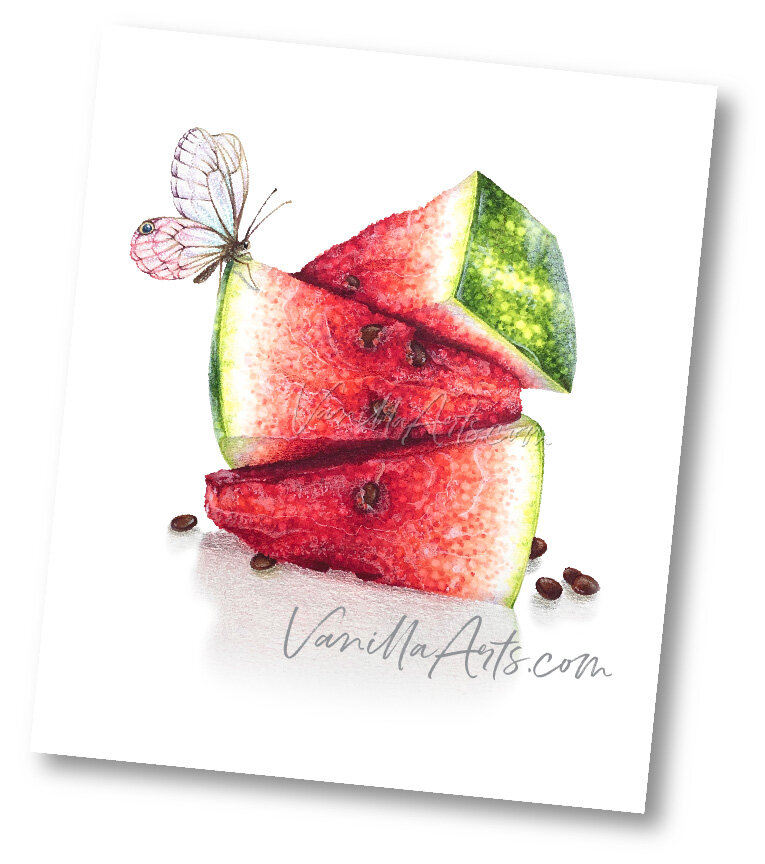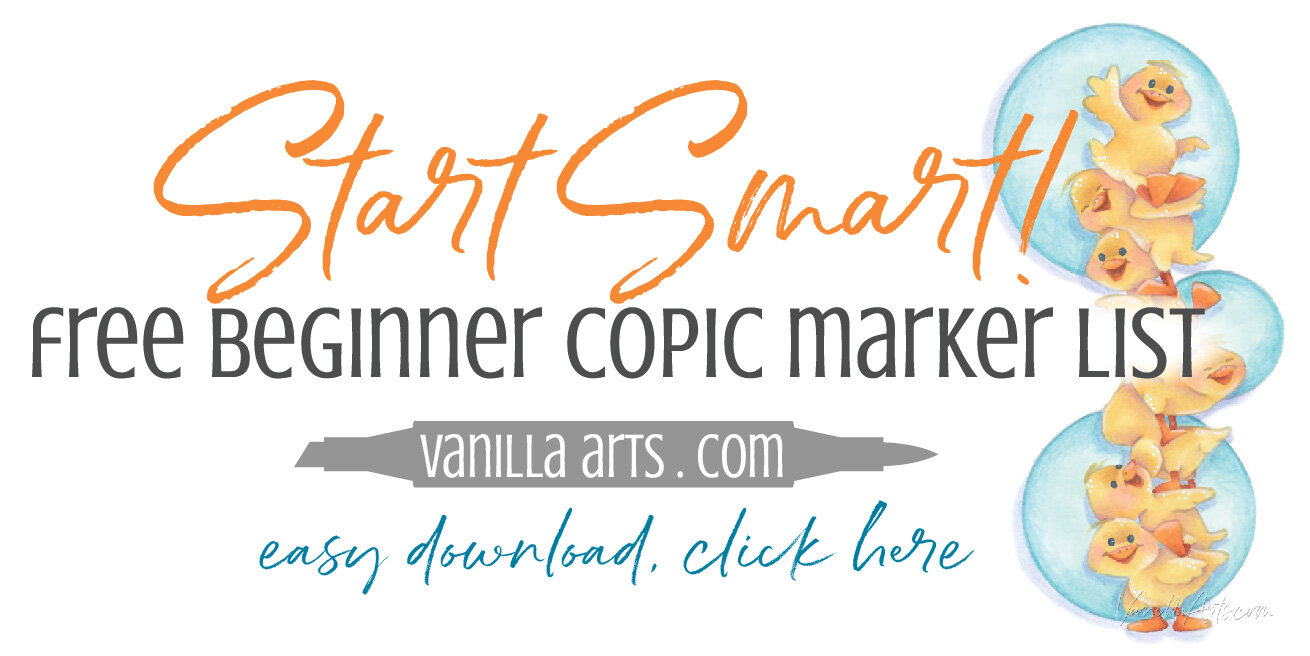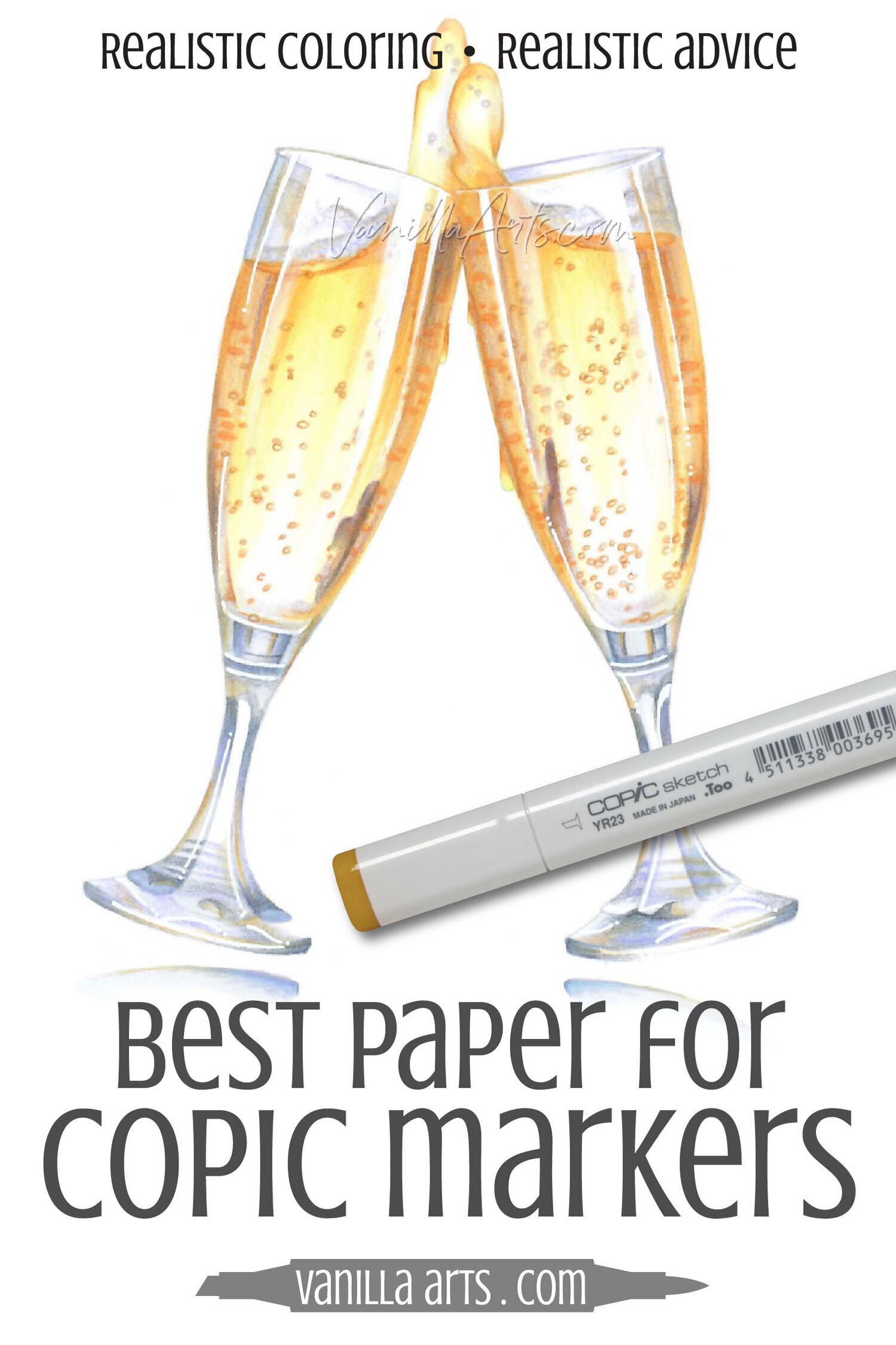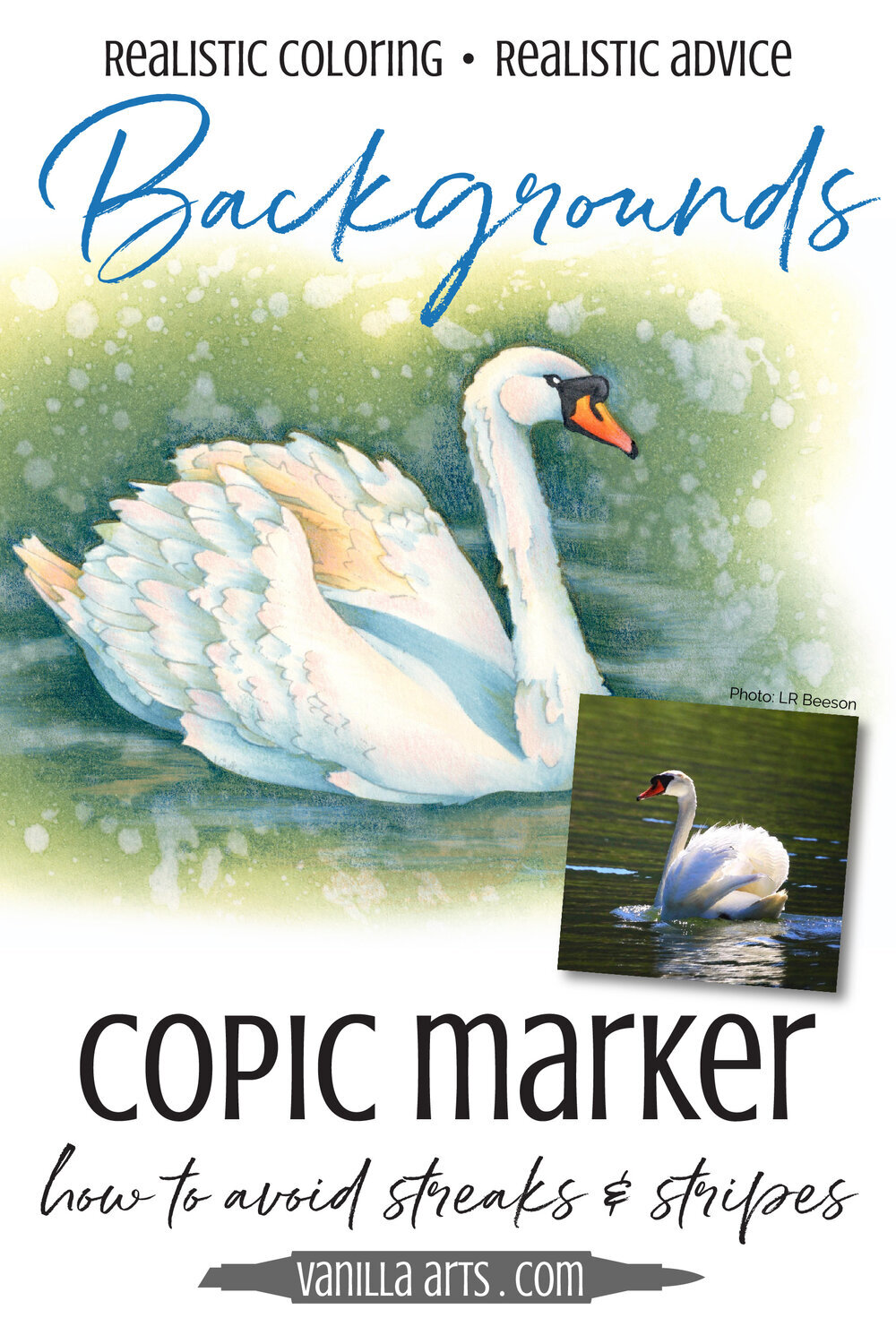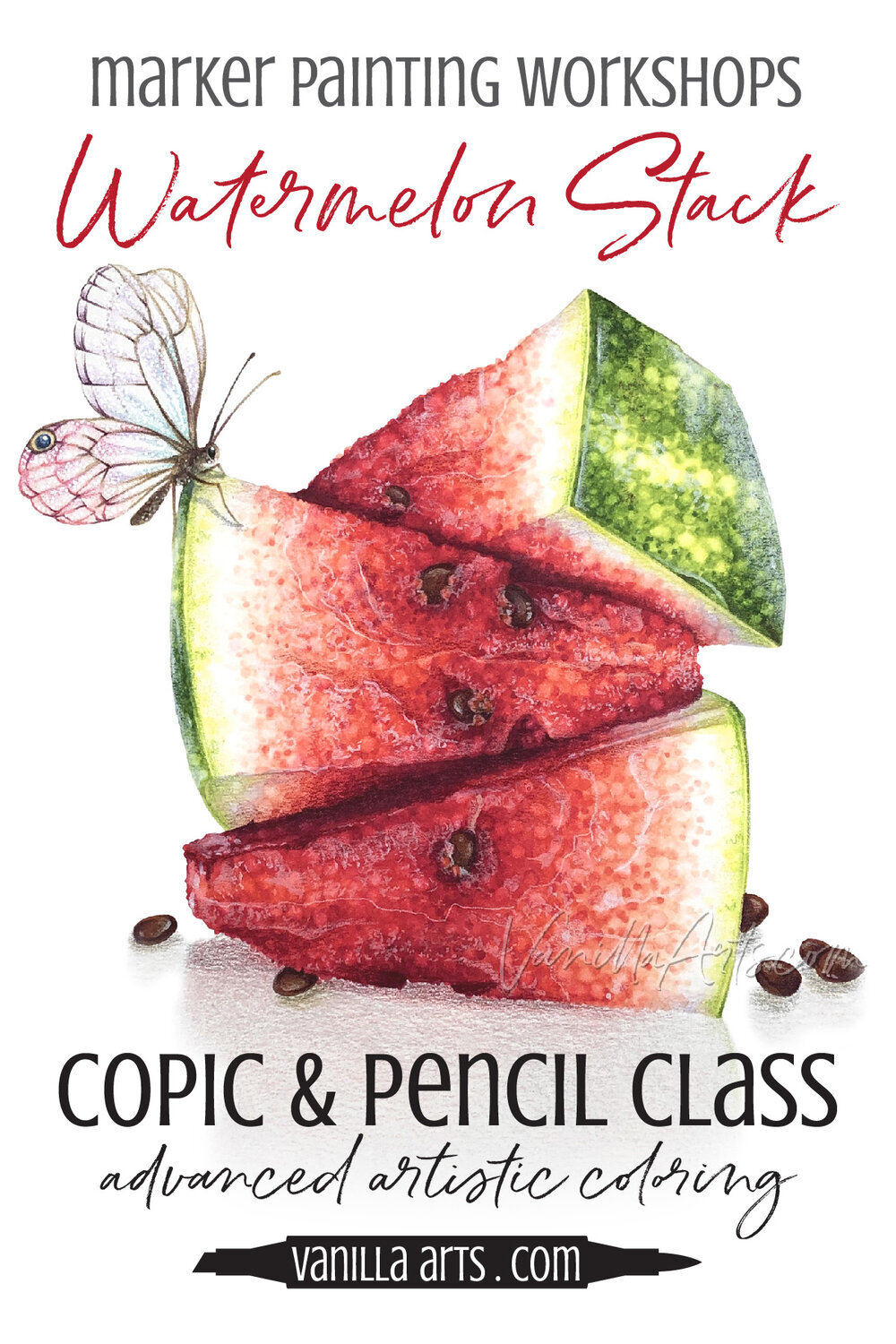I’ve taught marker coloring classes for over a decade, including hundreds of beginner classes.
There’s nothing scary about a marker. They look easy and feel familiar in your hand. Because they’re so approachable, new students walk into my classes already familiar with several different brands of markers, some alcohol and some water-based.
Beginners always want to know which markers are best for coloring— alcohol or water-based markers?
I teach with alcohol markers because I really, really love Copics.
But my marker recommendations may surprise you.
Are alcohol markers best for coloring?
Alcohol markers are preferred by professionals because they blend smoothly and come in a versatile range of mature colors. But alcohol markers are more expensive and require specialized techniques and paper. They may be overkill for card making and do not work well in journals or coloring books.
Let’s look closer at markers and how to find the best marker for your art.
Note: this article contains affiliate links to products mentioned. We only link to products we endorse and we source them to retailers we use and trust.
Alcohol Markers vs. Water-based Markers
What is the difference between alcohol and water-based markers?
It’s all about the solvent. Solvent is the fluid component of marker ink; it’s the stuff that makes a marker wet.
All marker inks are a combination of dye and solvent:
Alcohol inks are a proprietary mixture of alcohols (usually ethyl, methyl, and propanol) plus dye
Water based inks are water plus dye
CORRECTING BAD INFO: Markers do not contain pigment. You may read “this marker is highly pigmented” but in art supplies, pigmentation often refers to strength of color, not actual pigment particles. Markers use dye, not pigment.*
*Winsor Newton Pigment Markers may be an exception
Dyes love to blend but they can only blend well when the dye particles are swimming in a generous ocean of lubricating solvent.
Alcohol makes an ideal solvent for dyes. There’s a slickness to alcohol and its molecular structure distributes dye particles evenly throughout the solution. The best blending marker on the market, Copic uses Ethyl Alcohol (see the MSDS sheet here, ingredients on page 2-3) to keep the dye particles loose and ready to blend.
Water is simply not as ideal. First off, there aren’t as many water soluble dyes available. “Soluble” is actually a misnomer; water-soluble dye do not actually dissolve into the solution. The undissolved dye particles have a tendency to settle over time which is why you have to shake some water-based markers or store them horizontally. There’s also a magnetism to water which draws the undissolved particles to the outside edges of the wet zones on paper, leaving noticeable drying lines.
Unfortunately, water-based markers do not blend as well as alcohol markers. Because it takes several minutes for water to evaporate, marker companies are forced to make water-based markers less juicy to prevent smudges and smears as you color. The dryer application is a problem for smooth-blending because there’s not enough moisture for the dye to smooth itself on the paper. This forces you to use manual friction (scrubbing) to make the colors blend. Low moisture is also why water-based markers are notoriously streaky.
“Watermelon Stack” uses a combination of markers. The watermelon slices were colored with Copic Markers (alcohol based). The butterfly was colored with Staedtler Triplus Pens (water based). Artist: Amy Shulke of Marker-Novice.com and VanillaArts.com.
Additionally, water is not paper friendly, even watercolor paper uses a starch barrier called sizing to limit the paper’s exposure to water. Water causes paper fibers to swell which leaves the paper in a fragile state. This is why you’ll see pilling as you apply friction during the blending process. With a heavy all-over application of water-based marker ink, you’ll also see paper warpage.
Last, water-soluble dyes tend to be unstable and not very durable, they fade fast and unevenly. Artist grade alcohol inks still fade but they do so more slowly. Read more about lightfastness in my article here but for now, understand that there is currently a gigantic difference in the quality, durability, and blendability of water-based inks.
But aside from these issues, water-based markers have several great qualities:
water-based inks are child friendly and often non-toxic
they’re inexpensive to produce making for a more affordable marker
water-based inks work with a variety of creative nib styles, everything from tiny bullet nibs for details up to large bristled paintbrush styled nibs
because the markers are less juicy, they offer more control and less bleed-through
This isn’t a case where one kind of solvent is best. Alcohol markers are good. Water-based markers are good too. They each serve a purpose.
The question really is, what is YOUR purpose?
Alcohol Based Markers
Pros
smoother blends, less streaking
juicy nibs make blending easier
fast evaporation for less smearing & smudging
inks can be reactivated (and you can fix mistakes) by applying more alcohol ink
inks are less likely to be accidentally reactivated by drips, sneezes, or hand moisture
nibs tend to be higher quality, more responsive to pressure
marker bodies tend to be ergonomically designed
better quality caps with more reliable seals
some brands are refillable and offer replacement nibs
wider range of colors
more natural colors, designed for mixing
alcohol inks tend to scan/photograph more accurately
can be used on surfaces other than paper
many brands sell both sets and open-stock colors
easy to find used assortments online at a significant discount (buyer beware!)
Cons
initial investment is more expensive but refillable brands are far more economical long term
fewer stores carry alcohol markers and if they do, many only offer a limited range
buyer beware when purchasing from a local retail chain with uneducated staff— I’ve heard about and also personally witnessed damaged/returned markers going directly back into the sales display!
sets are often “sampler packs” rather than the necessary colors to complete a project
a few brands (especially Copic) have been counterfeited, look for authorized retailers for guaranteed authenticity
not lightfast (but the fade is slower)
slight odor to some brands
require specialized paper
requires some instruction and there’s a definite learning curve
Water Based Markers
Pros
inexpensive
easy to find in craft stores and office supply chains
easy to buy online
because they’re usually sold in sets, there’s less chance of damaged markers being resold as new by disreputable retailers
colors are fun and vibrant
disposable (if you tend to lose markers)
low/no odor
child friendly
sets usually offer a full range of useful colors
easy to master without instruction
on small stamps or images, it’s often hard to tell if the image was colored with alcohol or water based markers
low moisture nibs make them better suited to coloring books and bullet journals (less moisture means less bleed-through)
can be rewetted with a wet paintbrush for interesting watercolor-like effects
Cons
very few brands offer open stock colors (when a marker runs out, you must purchase a whole new set rather than a single replacement)
notoriously streaky
can be difficult to blend— this is often why they’re often used as “watercolors” because to fully blend, you’ll need extra moisture
trying to fix a mistake often makes it worse
even the slightest bit of accidental moisture can ruin a project
colors are often artificially bright or florescent
colors are often inappropriate for blending, mixes frequently look muddy or ugly
low quality nibs fray easily or lose their points long before you run out of ink
nibs tend to be hard and unresponsive— frustrating for professional artists
water is not compatible with most papers— causes paper fibers to swell, leads to warped paper and pilling with friction
low quality dyes fade extremely fast, discoloration can look very odd and ugly
water-based marker lines tend to spring up and disappear suddenly without warning. Most are trendy and unserious products rather than supplies you can buy for decades
Now that we’ve compared the two marker types, it’s time to think about how you intend to use them.
What kind of coloring do you do?
This is the million dollar question…
Expensive markers can’t make bad coloring look instantly better.
Markers are just a tool. Your markers don’t provide the skill, technique, talent, or creativity. That part is up to you.
Expensive markers are also a complete waste of money if you’re not using them on the correct paper or on the right sized projects.
Coloring is always easier when you match the right tool to the task.
So let’s look at the different kinds of coloring and which markers tend to work best in each circumstance.
Coloring Books: Coloring books are usually printed on manila style paper which frankly doesn’t work well for alcohol OR water-based markers. Because manila is a low quality, wood pulp paper which degrades easily when wetted with alcohol or water. Quality varies from book to book which leaves coloring book fans constantly disappointed when the images they love are printed on terrible paper.
Marker fans often trace coloring book outlines onto appropriate paper. I’ve even heard of Copic users taking pages to print shops to have them professionally reprinted onto their favorite marker cardstock.
Join a coloring book discussion group or search online for specific books printed onto better quality papers but at this time, I’m unaware of any coloring book printed on the ideal paper for Copic Markers. You’ll find books that aren’t too bad but nothing that’s perfect for markers.
BUST THE MYTH: I’ve heard coloring book people talk about “thick paper” as being the primary requirement for using alcohol markers in a coloring book. They also talk about “artist grade paper”. Yes, the best paper for alcohol markers tends to be thick but thickness isn’t what’s most important. It’s the type of paper fiber and the paper finish which makes a good marker paper, NOT THICKNESS. And “artist grade paper” tells you nothing. There are thousands artist grade papers and I’ll bet only 1% of them are suitable for alcohol markers.
For my favorite papers, see the recommend supply list here.
I recommend using water-based markers for coloring books. My reasoning is that they’re a dryer marker so you’ll see less bleed-through and less feathering (where the ink travels out farther than you intended). Plus, the coloring spaces tend to be small. Small spaces are easier to keep wet so you can usually get a nice look from water-based markers.
If you want to use alcohol markers in coloring books, I’d stick with a cheaper brand of marker. This is definitely a situation where the premium features of a Copic Marker provide no benefit if you’re coloring on manila.
Geometric Doodling and Mandalas: I’ve noticed that most “zen” or geometric doodling tutorials use Micron Pens first, the color is added later.
MICRONS ARE NOT SAFE FOR USE WITH ALCOHOL MARKERS. Read my article here about the danger of using Microns with Copic Markers. Stick with water-based markers if using a Micron pen.
BUST THE MYTH: Micron Pens are NEVER safe for use with alcohol markers. There is no amount of cure time, no amount of heat setting, no prohibitive paper, and no magic pixie dust which can prevent smearing. Microns use alcohol soluble ink, they will smear and drag color when they come in contact with alcohol ink. They also ruin alcohol marker nibs.
If you switch to a pen that’s safe for alcohol markers, then feel free to use any brand of alcohol marker including Copic. See my article here for a list of recommended Copic safe pens.
Note: unless you’re doodling/drawing on marker friendly cardstock, there is no benefit to using Copic Markers for these projects. See my article here for a list of recommended papers for use with Copic or other alcohol markers.
Card Making, Stamped Images, and Scrapbook Elements: Use whatever kind of marker you prefer. As long as you match your marker to the correct kind of paper, you’ll get great results from both water and alcohol markers, even inexpensive brands of alcohol marker work great.
That’s the beauty of coloring small images- it’s easy to get great results.
I get a lot of card makers in my Copic Marker classes and while I teach with Copic exclusively, I don’t think Copics are necessary to make beautiful cards. If you enjoy using Copics, go ahead; but don’t assume you need all 358 Copic Markers to make attractive cards.
Read my article here about the limitations caused by owning too many coloring supplies.
For stamped images, make sure to match your stamp ink to the type of marker you intend to use.
Do not use water-based stamp inks with water-based markers unless you want the stamp ink to bleed or melt away.
It is essential to use a stamp ink which is safe for alcohol markers. Unsafe inks will ruin the nib of alcohol markers.
Digital Stamps (small or full page size): If you’re printing small images to color, you can use any kind of marker you enjoy, including inexpensive alcohol markers. Just like with card making, when the image is small, it’s very easy to get great results with any product.
For larger digital stamps, especially full page images, you’ll need to step-up the quality of products you use. The larger the image, the more you’ll appreciate quality markers designed for large scale blending and coloring.
If you’re using water-based markers, you’ll likely want to add a paintbrush and clear water to get smoother blends or create watercolor like effects. Water-based markers are at a clear disadvantage when coloring large. You’ll also need to switch to water friendly paper which can resist buckling, warping, and pilling.
For alcohol markers, be sure to print on a quality marker friendly cardstock. This is where I’d definitely recommend Copic Markers.
And for both kinds of markers, make sure to use a printer with marker compatible ink!
Ink Jet printer lines melt on contact with water
some Ink Jet printers are safe for use with alcohol markers but test first to be sure!
toner printers are safe for both water-based and alcohol markers
Bullet Journals and Art Calendars: Like coloring books, you’ll have paper issues no matter which kind of marker you choose.
You’ll also encounter bleed-through issues with both kinds of markers, so thicker paper or one-side-only usage is definitely advised.
For journals, I’d recommend sticking to thin barreled water-based markers because thinner markers tend to be less juicy. I like these water-based brush nib markers or for a thin alcohol version, I really like these.
But I have to admit, I’ve seen amazing work with full sized alcohol markers. If the paper is right, you can get away with a juicy alcohol marker.
Art Journals, Sketchbooks, Urban Sketching, and Illustrative Journals: This is a hard one. Here, you’re drawing and coloring to your best ability so you’ll want the best blending markers you can find BUT you’re limited by the paper quality. Like coloring books, you’ll find a wide range of journals printed on tons of different papers.
It’s really up to the paper and your skills as an artist.
You can get great results from water-based markers, from cheap alcohol markers, or from Copic Markers IF you can match the paper to your markers.
What I can tell you is that most art journalers buy and try every journal they see or read about. They’re always searching for the best paper for their favorite marker. Once they find it, they buy a bunch and then pray that the brand doesn’t get discontinued.
I make my own marker journals using my favorite Copic friendly cardstock, binding it between these cover-boards using this binding machine. I’ve used the same binding supplies with watercolor paper to make lovely watercolor journals as well.
Comic/Manga Fan Art: Okay, I’m dividing this category. Here we’re talking about amateurs and hobby level fan art. If you’re a professional comic illustrator, you’re likely not even reading this article in the first place but the pros should skip ahead to the last “illustrator” category if you’ve lasted this far.
For the amateurs and beginners— this is a category of aspiring artists who are often held back by their supplies.
For professional looking work, you need 3 things: great paper, great markers, and great technique.
I highly recommend Copic Markers. If you’re trying to duplicate the style or look of your favorite artist, your best chance is to use the same supplies. Most professionals use Copics but if your hero is using fruit scented dollar store markers, you should be using fruit scented dollar store markers too.
Match your paper to the markers. I see a ton of fan-artists using expensive Copics on cheap copy paper. It’s a waste time and ink.
I’ve seen a lot of talented people stuck in this category. Stuck because they keep searching for the cheapest answer to everything. Water-based markers and Copic knock-offs won’t cut it at the level you aspire to.
For a budget friendly starter list, here’s my versatile starter marker shopping list. I teach beginner classes with this set and we ran classes for over a year without adding any new colors..
Line & Wash Sketching: I do a lot of this myself and I know the “wash” typically refers to watercolor.
But a lot of artists are doing this on the road or en plein air with water-based markers. I have Winsor Newton Watercolor Markers (which are actual watercolor rather than dye) and I’ve also enjoyed playing with Zig Clean Color brush pens (water-based dye).
There are many water-based markers which will work here.
And don’t forget, alcohol markers can work well too. You won’t get the same watercolory effects, it’s more of a Line & Swash look but it’s a lot of fun and actually harkens back to old school marker indication projects.
Designers— Storyboard, Fashion, Graphic Design & Logos, Product Illustration, Interior Decorating, Landscape and Architecture: Copic Markers, Copic Markers, Copic Markers. But you already knew that, right?
Production art requires professional grade materials. Copics are refillable and have replacement nibs. Every other marker will cost more in the long run. I’m preachin’ to the choir, right?
Illustration, Marker Painting, and Fine Art: We’re not even going to mess around with water-based markers now.
Once we’ve narrowed ourselves to alcohol markers, it’s all about the nibs. We need high quality, juicy, and expressive nibs for marker painting.
I’ve tried a lot of alcohol markers at this point and nothing compares to the Copic Super Brush Nib. It’s longer, springier, and more durable than anything else on the market. To be frank, the Super Brush Nib is why I don’t teach with anything else.
Can you get good results from inexpensive markers?
I know this will surprise some of my long time readers— after all, I teach Copic Marker classes, I’m a big cheerleader for the most expensive brand of alcohol markers…
But I don’t think everyone needs expensive markers. Cheaper markers can make very beautiful coloring.
Now I need to qualify that statement, there’s a great big IF coming.
You can get great results from student-grade markers IF you have the knowledge and skill to overcome the hurdles you’ll face with these inexpensive markers.
And that’s the problem…
Do YOU have the skills to make bad markers look good?
Artistic skill, training, experience, and natural born talent makes any product easier to use with success. A pro can get away with using lesser markers, but honestly, when time is money, professionals know quality tools make art more efficient.
Professional tools make art easier.
Professional tools also make learning easier.
I know this sounds counterintuitive to a beginner.
A lot of people figure they’ll start with cheaper markers and upgrade later when they have enough skills to justify expensive markers.
I disagree.
Every hurdle you put in your way makes learning harder:
It’s harder to learn how to blend with ink that doesn’t want to blend
It’s harder to color smoothly with a marker that isn’t naturally juicy
It’s difficult to blend or cover large areas with a tiny nib
It’s difficult to control unresponsive nibs
I teach with Copic Markers because it’s easier to learn good technique with good markers. With quality markers, you focus on learning rather than fighting the marker.
But I know professional markers are not in everyone’s budget.
So if you’re stuck with a lesser marker, let me give you a few tips for using water-based markers or cheaper alcohol markers:
Choose alcohol markers over water-based if you can. You’ll instantly get better blending and have better colors to choose from.
If you insist on sticking with water-based markers, seriously consider using a paintbrush to create watercolor effects. You’ll avoid the streakiness and maybe develop a desire to try real watercolor.
Keep your projects small. The smaller the area, the easier it will be to blend.
Bold stamp lines or sketchy outlines can make bad markers look better. Black outlines attract attention and distract from coloring mistakes.
Consider adding colored pencil over the top of cheap marker— as I said with stamp lines, we’re using pencils to distract the viewer but pencils can also camouflage blending fails and smooth choppy looking areas.
When your markers are cheap, your choice of paper choice is even more critical. Choose quality marker friendly cardstock or hot press Bristol board for alcohol markers. For water-based markers, choose a smooth high quality cardstock which doesn’t pill or warp when exposed to water.
Are alcohol markers best for coloring?
Overall, I think alcohol markers are much better than water-based markers for coloring but there are times when a water-based marker really comes in handy.
Alcohol markers are preferred by professionals because they blend smoothly and come in a versatile range of mature colors. Copic Markers are especially favored by professionals because they’re refillable, offer replacement nibs, and individual markers can be replaced open-stock if necessary.
Water-based markers are a better fit for coloring books and journals because they’re less juicy than alcohol markers and thus less likely to bleed-through or feather. And when the coloring project is small, water-based markers often look just as good as their more expensive alcohol counterparts.
Remember, expensive markers aren’t a guarantee of success.
Quality tools make coloring easier but you can get great results from cheap markers if you have the knowledge and skill to overcome the quirks of inexpensive markers.
And one last bit of advice…
I know if this is the fist time you’ve shopped for markers, this whole question about which kind of marker to try and which brand to buy feels like a monumental decision.
But they’re just markers.
It’s just paper.
You’re just experimenting right now.
Go with the best marker you can afford and if that doesn’t work, you can always try something else. This is what artists do all the time, we play and experiment with a wide range of materials to see what works best and what feels best.
You’re not locked into this purchase forever.
Now go play with some markers!
Amy Shulke is a professional illustrator who has used Copic Markers since 1990. She teaches artistic coloring classes online at VanillaArts.com and locally in south-eastern Michigan.
Marker Novice is Amy’s completely free resource devoted to beginner marker education. For intermediate/advanced artistic coloring articles, see her Studio Journal here.
Further reading on related topics:
Click to read the article here or at our sister site, VanillaArts.com
Watermelon Stack
Learn to create touchable food texture
Stop treating pointillism like a novelty technique. We’re exploring the advanced use of this simple dotting technique to create tasty texture for food illustrations.
Realistic Coloring with Copic Markers and Colored Pencils
Real time coloring with real mistakes and real fixes.
This Marker Painting Workshop was recorded live with no speed coloring or edits.
Edited classes with perfect narration tend to make the coloring process look faster, easier, and smoother than it actually is. Stop comparing yourself to the rehearsed, enhanced, supermodel version of an artist!
Class Printable Pack Includes:
Class syllabus with detailed recipe guide
Full color project sample
Guide to Copic base
Detailed color map
Project inspiration references
We recommend these products for use with Copic Markers:



